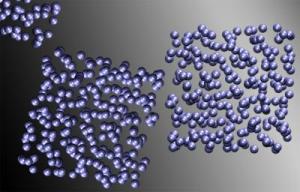Mar 25 2014
Some experiments are really difficult to perform in practice. To gain a detailed understanding of the behaviour of molecular hydrogen (H2), for example, we would have to produce such high pressures as those occurring within the core of gaseous planets like Jupiter and Saturn or inside stars. If such conditions cannot be created, an alternative method is to simulate them on the computer, but the model has to be accurate.
A group of research scientists from the International School for Advanced Studies (SISSA) in Trieste used a simulation model that is far more accurate than previously used, and carried out an experiment to test a hypothesis about the behaviour of hydrogen that is splitting the scientific community.
 This image shows a simulation of hydrogen atoms. Credit: SISSA
This image shows a simulation of hydrogen atoms. Credit: SISSA
"We developed this simulation method here at SISSA over the past ten years", explains Sandro Sorella, a SISSA professor and co-author of the paper. "It's a highly accurate technique based on the quantum Monte Carlo method – a family of algorithms but usually limited to a small number of particles – that we have developed in order to consider now a large number of atoms, and obtain an almost realistic situation. A great advantage".
"We used the simulation to verify the Wigner and Huntington prediction", adds Guglielmo Mazzola, from SISSA and first author of the paper.
In 1935 Eugene Wigner and Hillard Bell Huntington conjectured that at very high pressures, when hydrogen makes the transition from the "molecular" phase to the "atomic" phase (when the atoms are so close to each other that the molecular structures can no longer be distinguished), hydrogen acquires metallic properties.
"In recent years, attempts to verify this hypothesis both theoretically and experimentally have yielded conflicting results with regard to the pressure required to achieve 'metallization'", comments Mazzola. "Our simulation, in the liquid phase, showed that we might indeed be very far from being able to observe this transition experimentally. According to our findings, metallization can only take place at pressures approaching 500 gigapascal. This is an enormous value, which only occurs in the innermost layers of gaseous planets and cannot be achieved with currently available experimental equipment".
"A detailed understanding of the phase diagram of hydrogen", concludes Sorella, "is not only important for studies in the field of astrophysics, but also for learning how this element behaves and, for example, under what conditions it becomes a superconductor".
Source: http://www.sissa.it/